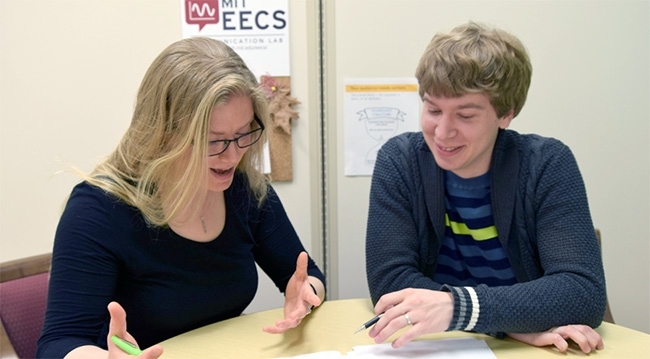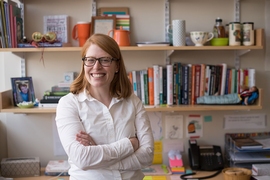In the spring of 2015, graduate students communicated a clear message to the Department of Electrical Engineering and Computer Science (EECS): They needed help communicating.
Specifically, they wanted to give better pitches for research and startup ideas and make presentations that wowed their colleagues and senior scientists. They also wanted to impress recruiters, who saw plenty of candidates with technical skills, but it was always the applicants with strong communication skills who really stood out from the pack.
Samantha Dale Strasser, a PhD candidate in EECS, says students were particularly stressed during conferences, when they realized their talks weren’t what they could be.
“Coming from MIT, we really want to be not only at the forefront of science, but also the forefront of communicating that science,” says Strasser, who was among the graduate students who provided the 2015 feedback.
In response, the department launched two initiatives: the EECS Communication Lab, a peer-coaching resource, and a new lab-supported class, 6.S977 (Technical Communication). By all accounts, both initiatives have succeeded, resulting not only in improved pitches and posters, but in a stronger department-wide awareness of power of effective communication as well.
The Comm Lab, as it’s affectionately known, employs graduate students and postdocs from across EECS to serve as peer coaches. The coaches have been trained in how to strengthen their own communication skills, including how to consider their audiences and purposes, how to generate excitement about their research, and how to create narrative rather than litanies. As a result, the communication advisors are ready to provide one-to-one help to virtually anyone in the department, including undergraduates, graduate students, and postdocs.
“The Comm Lab is a great resource,” says Priyanka Raina, a PhD candidate in EECS who consulted the lab for a wide range of assignments including a conference paper, a presentation, her resumé, and a faculty package. “It helped me a great deal. All the assignments that I worked on with the lab were accepted or saw positive results. I even got an interview with a top university.”
The EECS Comm Lab is the latest installment of the Communication Lab program, a School of Engineering resource. The departments of Biological Engineering, Chemical Engineering, and Nuclear Science and Engineering also have their own communication labs, as does the Broad Institute of Harvard and MIT. The model has expanded quickly because it serves students at the time when they need it most, says Jaime Goldstein, the program’s former director.
“Early scientists need to get funding, get a job, go to conferences, and meet collaborators,” she says. “We insert ourselves at just that right moment with just the right information. And peer coaches know how to ask the right questions because they're insiders in the field. It’s a real recipe for success.”
Faculty members agree. In addition to that first Technical Communication class, the Comm Lab has hosted workshops and supported other courses. In January of this year, the Comm Lab provided a training session for graduate students presenting at the Microsystems Technology Laboratories’ Microsystems Annual Research Conference.
“Industry members and faculty commented that the quality of pitches showed marked improvement this year,” says Ujwal Radhakrishna, the EECS postdoc who organized the conference.
Research abstracts and presentations in 6.336 (Introduction to Numerical Simulation) have also been notably clearer than in the past, says Luca Daniel, an EECS professor who instructs the Comm Lab-supported class.
“The abstracts felt a lot better organized, with engaging motivations, detailed concise methods and results descriptions, and thoughtful considerations at the end,” Daniel says. “The presentations were also more accessible to a wider audience. My class has students from 12 different departments, so that’s essential.”
Daniel wasn’t the only one enthusiastic about the Comm Lab results in his course. Asked whether he should again use the resource in his course, he says his students also responded with an emphatic “yes.” Students also suggested adding midterm deadlines, in addition to deadlines for final abstracts and presentations, to encourage even earlier visits to the Comm Lab.
“They love the fact that it is other students helping them,” Daniel says.
Diana Chien, the current director of the school-wide Communication Lab program, understands the appeal. “In technical communication, you really can't separate the science or engineering from the communication, so our advisors are ready to tackle both at once,” she says. When EECS clients visit the Comm Lab to work on conference presentations with communication advisors, they’re really connecting with peers. The advisors are “as ready to parse details about the design of a machine-learning algorithm as they are to ask strategic questions about audience and storytelling,” Chien says.
Chien and the communication advisors also created an online resource, the CommKit, to guide students through several common communication tasks, such as a cover letter or a National Science Foundation application. If an impending deadline precludes students from meeting an advisor in person, help is still just a click away.
The Comm Lab’s popularity is growing. Since September 2016, advisors have scheduled more than 300 appointments with 180-plus advisees. More than 270 students attended workshops on posters, pitches, thesis proposals, and the Research Qualifying Exam (RQE). Feedback from the Comm Lab’s first annual survey remarkably showed that of the respondents who had visited the lab, all of them would recommend it to a friend. And while many students and postdocs haven’t yet used the lab, more than three quarters of non-users surveyed indicated they were still glad that EECS offers the service.
School of Engineering Dean Anantha Chandrakasan says the enthusiastic and sustained interest from students and faculty "tells us the program’s doing exceptionally well.”
“I expect the Comm Lab will become a staple resource in the department,” says Chandrakasan, who is also the Vannevar Bush Professor of Electrical Engineering and Computer Science and a former EECS department head.
Chris Foy, a PhD candidate in EECS who took the communication course and is now a peer coach, says skills taught in the Comm Lab have a clear professional impact. He ranks the Technical Communication class as one of his favorites at MIT, in part because it taught him how to focus on building a rationale or a narrative about his research.
“Being able to do this is crucial as a scientist because there are so many problems that are, in theory, worth solving,” he says. “But if you can’t construct a story around why you chose this problem,” he adds pointedly, “then why are you solving it?”
Joel Jean PhD '17, who received a doctorate in electrical engineering in May, credits his communication-advisor training with helping him clearly explain his vision for working on thin-film solar cells to help address climate change. That effort paid off: Jean won one of MIT’s most prestigious graduate awards, the Hugh Hampton Young Fellowship.
“My return on investment from working with the EECS Comm Lab as an advisor has been extraordinarily high,” he says. “And I expect its value, both for me and for students in the department, to keep growing.”







